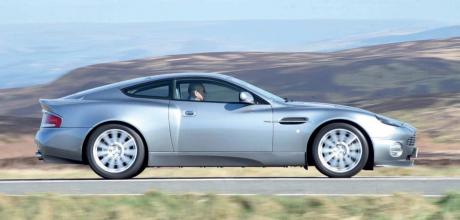2001 Aston Martin Vanquish
To mark the 25th anniversary of a unique concept the eventual Vanquish production model was based on, we’re driving an example of the V12 supercar across one of the UK’s best driving roads.
WORDS & PHOTOGRAPHY PAUL WALTON
FIRE POWER VANQUISH V12 AM’S BEST SUPERCAR
We drive the model that got 007 back behind the wheel of a modern Aston Martin for the first time in 15 years, the magnificent Vanquish V12
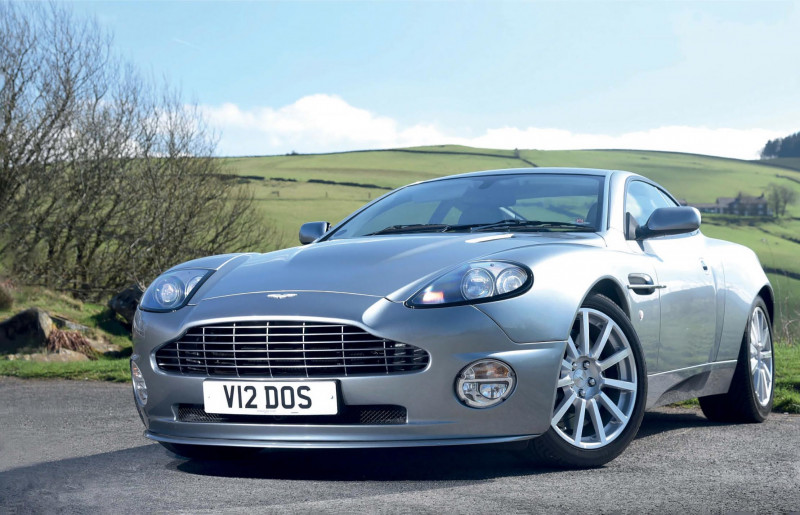
After climbing for what seems like thousands of feet, the road finally flattens to reveal the full barrenness of the Peaks. With nothing ahead of me but empty tarmac, I pull the left-hand paddle mounted on the steering column, feel the six-speed ‘box clunk down a gear before flooring the throttle. The moorland immediately becomes a blur of green and yellow as I do so, the hardness of the V12 coupe’s acceleration matching that of the view around me. Thanks to the isolated location and the car’s performance, I can’t help but feel like I’m in a Bond film. But while there’s no doubting that I’m more Norman Wisdom than Pierce Brosnan, with the Vanquish appearing in Die Another Day, it’s an understandable daydream.
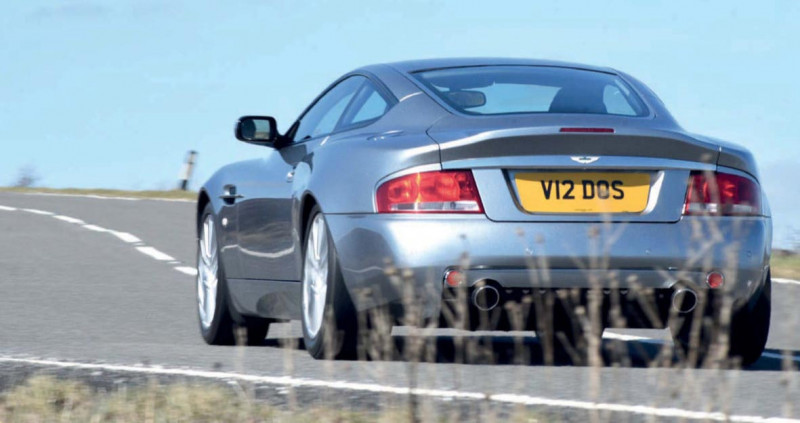
Yet the car is more than just a movie prop; fast, responsive, and full of contemporary technology, it’s considered by many to be one of Aston’s best and most important sports cars from the past 25 years. To discover if this is true, I’m taking a 2005 example across one of the UK’s best driving roads, the Cat and Fiddle in the Derbyshire Peak District.
The origins of the Vanquish go back to early 1997 and a meeting between Ford’s vice president, Jac Nasser, with several Jaguar executives and Bob Dover, Aston Martin’s then CEO and chairman. According to Dover, Nasser initially asked the Jaguar people if they wanted a concept for a forthcoming motor show. When they said no, Nasser said the same question to Dover. “I replied that I did,” he says in David Dowsey’s 2007 book, Aston Martin Power, Beauty and Soul. Nasser said he’d give a million dollars to fund the project and that it should be called the Vantage Project since the name was synonymous with high-powered Astons.
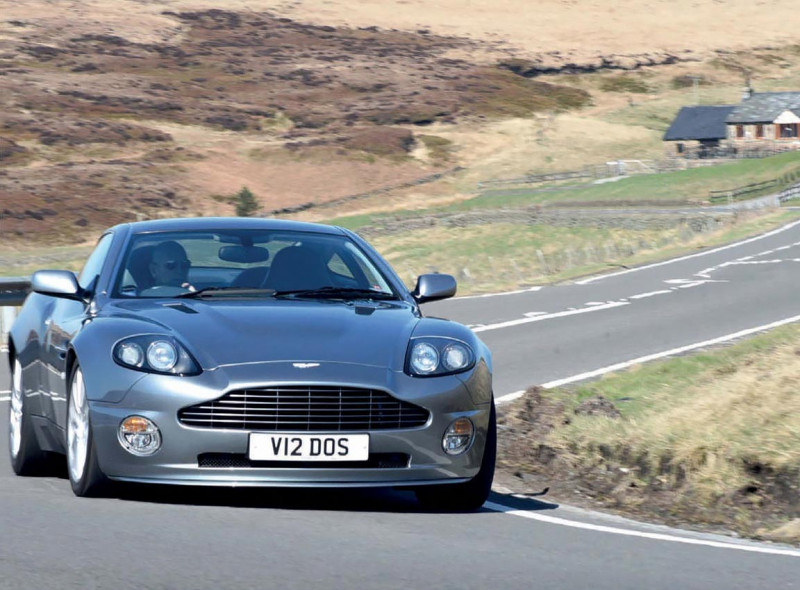
“There are a number of reasons for doing a concept car,” continued Dover, “to gauge opinion when you are not confident about the design, to see whether you can stretch the boundaries a bit.”
The project’s timing, though, would be tight. “Jac wanted us to try and get it finished for Detroit [Motor Show] as a concept car the following January [1998],” continued Dover in Power, Beauty and Soul, “which meant we had to get it finished by about mid-December and freeze everything by about October.” Dover quickly put everything in place to develop such a concept which included finding a stylist. After contacting several other British designers, Dover eventually went to TWR’s Ian Callum who had been responsible for bringing another Aston Martin to production in the early Nineties. “I was not so presumptuous to think because I had done the DB7 that I would automatically be considered for the job,” said the Scot in David Dowsey’s book. “I didn’t think for a minute that I would automatically pick up the mantle at Aston Martin. I had some stripes but I wasn’t that arrogant. So I went to meet Bob.” The meeting was successful.
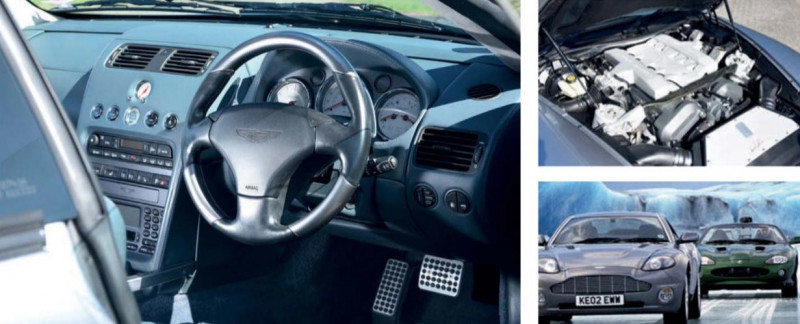
“In March [1997] we gave the [development] job to TWR,” continued Dover. “My brief to Ian was that I wanted something a bit more aggressive than the DB7, somewhere between the V8 and the six-cylinder DB7, which turned into the Vantage Project.” Openly influenced by the DB4 GT Zagato of 1960, what Ian eventually created was a simple yet muscular car that although featured several of the older car’s design cues, was far from being an overly retro cliché. Importantly, it was exactly what the boss was looking for.
“When Jac Nasser saw the back of the car, he said ‘That’s the car that I want,’” recalled Callum. With Aston Martin seen by Ford as the pilot for forthcoming technology, the Vantage Project would be overflowing with new developments. The most important of these was the car’s tub being constructed from aluminium honeycomb while aluminium chassis sections and roof pillars were reinforced with carbon fibre. It was claimed at the time these materials and construction method saved more than 50 percent in weight compared to steel while also increasing torsional rigidity by more than 100 percent.
The other big news was the engine; the Vantage Project would be the first Aston Martin to be powered by a V12, beating the DB7 Vantage by a year. A 5,935cc unit with chain-driven twin overhead camshafts per bank and four valves per cylinder, it developed 442bhp and 320lb ft of torque. Aston Martin reckoned the V12 gave the Vantage Project a 200mph top speed and a 0-60mph time of just four seconds.
The engine began life in the early Nineties as a concept designed by Ford Advanced Vehicle Technology and Cosworth Engineering. Originally touted to power the Lagonda Vignale if the 1993 Ghia-designed prototype ever reached production, the unit finally broke cover at the Turin Motor Show in 1994. It was then used in Ford’s GT90 concept the following year and then in the Reynard-engineered, hot rod-inspired Indigo Show Car in 1996. TWR’s design manager, Neil Simpson, was responsible for the Vantage Project’s interior which featured both carbon fibre and aluminium trim while the seats were in saddle brown-coloured Connolly leather. Looking and feeling highly contemporary, it was very different from the traditional walnut-covered dashboard of the-then current but by now elderly V8 model.
Painted in a distinctive shade of metallic green called Derwent, when the Vantage Project made its debut at the 1998 Detroit Motor Show it was heavily praised by its critics. “Merely glance at the sinewy body shaping and drool begins to form at the corners of your mouth,” said the American magazine, Motor Trend, in September 1998 after being lucky enough to drive the fully functioning car, albeit at 50mph. “From the wide shoulders, hunkered-down stance, and aggressive-looking underbody tray to the graceful greenhouse arc and deft integration of the traditional Aston grille opening, this is one gorgeous machine.”
Unusually for a concept, the sole example of the Vantage Project wasn’t destroyed and after being kept by Aston, was sold at auction in 2016. After being in storage for several years, the car needed to be restored to bring it back to its original condition.
Aston might have publicly said the Vantage Project was merely a prototype, but it was a very different story behind the scenes. “We knew that if we got a lot of public support at the Detroit Show that we could build that car, which we obviously went on to do,” said Dover many years later. “We were confident we could put the Vantage Project into production, there was never any doubt that in my mind. It was just giving Ford the confidence that it could do it with the V12 engine as well.” Jac Nasser personally gave Dover the green light for the car after it was displayed at the Geneva Motor Show in March 1998.
“He looked at me and said, ‘You will do this and I will get my money back.’ That is how it was done. It was too small to go through the Ford Motor Company Product Approval process.”
The car was the first production Aston to feature a bespoke bonded aluminium composite chassis with a carbon fibre backbone that would influence Aston’s later VH platform, which all future cars from the DB9 onwards would be based on. A steel, aluminium, and carbon fibre subframe supported the engine while carbon fibre windscreen pillars supported the roof.
Hydro Automotive Structures in Worcester built the shell from extruded aluminium and carbon fibre that was then bonded to the chassis. After arriving at Newport Pagnell, it was clothed with hand-finished and superformed aluminium panels. Finally, each car received eight coats of paint and lacquer. Although the 5.9-litre V12 was retained, it was now in what Aston called a ‘Stage 2’ state of tune. This included a new air induction system, uprated camshafts and manifolds plus a revised crankshaft and valve gear which together increased power to 460bhp. But due to the Vanquish being 500kg heavier than its concept predecessor, the 0-60mph time increased by almost a second while the max speed was lowered to 186mph. Transmission was a similar six-speed Tremec manual gearbox as used in the DB7 Vantage, but changes were actuated by an electro-hydraulic clutch via Formula 1-style paddles on the steering column, a system that was developed by Magneti Marelli and previously seen in the Ferrari Modena F1.
“The technology was extremely important,” continued Dover in Power, Beauty and Soul. “We could have used a manual shift very easily but the paddle shift was something I wanted to do. The V8 was getting very out of date technologically, the six-cylinder DB7 didn’t break any new ground and we needed to get back at the top in terms of technology.”
Although the eventual production car looked similar to the Vantage Project, Callum made several minor changes to the design and other than the roof, none of the surfaces remained the same. The track was widened, the crease on the rear haunches was softened and the side windows were teased out a little to create more interior room. The side air intakes were also reshaped as was the location where the exhausts exited the rear valance.
Simpson’s starkly modern interior of the Vantage Project was not universally admired, so the cabin of the production car was more conventional. But there was still plenty of aluminium, meaning the dash remained more contemporary than that of the V8 models.
To continue Aston’s long tradition of V names, the car was christened Vanquish. Unsurprisingly, it received unanimous praise when it was revealed at the 2001 Geneva Motor Show in March.
“The Vanquish is a major step forward,” said Road & Track magazine in its November 2001 issue, “with a specification that makes the Ferrari 550 look staid and traditional.”
With Aston Martin moving to a new, purpose-built factory located outside Gaydon in Warwickshire during September 2003 where all future models would be made, the Vanquish was the last car to be wholly produced at the company’s historic home of Newport Pagnell. Unlike the model it was replacing, the ageing V8, it was only available in coupe form although the Italian carrozzeria, Zagato, did produce a single roadster prototype in 2003.
To solve the later issue of the much cheaper V12-engined DB9 from 2003 having 10bhp less power than the Vanquish, in 2004 Aston Martin introduced a faster version of its flagship model. Thanks to new cylinder head casings with fully machined inlet ports and combustion chambers that improved airflow, plus new fuel injectors and revised engine mapping, the power of the V12 was increased to 520bhp. This gave the car a genuine 200mph+ top speed while the dash to 60mph dropped slightly to 4.8 seconds.
As a way to make the car even sharper to drive, it was also given the originally optional Sports Dynamic Pack that featured changes to front suspension, which included revised damping plus shorter springs and steering arms. The brakes were also uprated with 378mm ventilated and grooved discs at the front and six-piston calipers. Since ‘Vanquish Vantage’ was considered too much of a mouthful, this new model that replaced the standard car in Aston’s range was called simply the Vanquish S.
“This derivative makes the car more special,” said Aston’s then new CEO, Dr Ulrich Bez, at the launch of the Vanquish S at the Paris Motor Show in September 2004. “It is the fastest and best handling car we have produced, the ultimate high-performance Aston Martin.”
To discover if that’s still true, I’m driving a Tungsten Grey Vanquish S over the famous Cat and Fiddle road that cuts across the peaks between Buxton and Macclesfield. Named after the inn of the same name located at the summit, other than the many speed cameras that line the road, its long straights, fast corners, and desolate location makes it the perfect test for this 200mph supercar.
The first thing that strikes me about the Vanquish is how it hasn’t aged. The basic design might be 25 years old, but the crisp lines, perfect proportions and aggressive stance make it appear surprisingly modern. Swap the oldfashioned multicoloured rear lamps for contemporary LEDs and it could easily be a current model.
If I’m being honest, the same can’t be said of the interior. Despite the acres of quality, hand-stitched leather covering every surface, since the switchgear in the centre console is the same as those used in my own considerably cheaper, mass-produced Jaguar XK8 from 2000, in my eyes it lessens the cabin’s appeal. The V12 starts immediately after I twist the Ford-sourced Tibbe key in the ignition and press the starter button located high in the centre console, sounding surprisingly quiet for such a large motor.
After pulling both of the steering column-mounted paddles at the same time to put the transmission into neutral and then the right one to engage first, I gently squeeze the throttle and start my ascent of the Cat and Fiddle.
The second thing to strike me about the car is how easy it is to drive at slow speeds. It might be a 200mph supercar but as I follow the heavy traffic it feels smooth, refined and surprisingly docile. This increases significantly when I learn to lift off the throttle slightly when I change gear that stops the car from uncomfortably lunging forward. It’s only as the road plateaus at the 1,690ft (520m) summit, which offers tremendous views across Greater Manchester way in the distance that, with the road finally empty and no speed camera in sight, do I finally change down and squeeze the throttle hard. Despite the car’s considerable size and weight, the V12 responds instantly, resulting in breathtakingly hard acceleration.
With the engine revving all the way to 6,000rpm, the cabin becomes filled with a high-pitched wail until I finally lift off the throttle a little, pull on the right paddle and change up.
Thanks to nicely weighted steering and perfectly damped suspension that results in limited body roll, the Vanquish is a fully accomplished sports car and I’m able to scythe the big car effortlessly through the Cat and Fiddle’s many sweeping S-bends with all the confidence of a V8 Vantage. That said, through a fast corner there is the feeling that a lot of weight is being hustled along.
With the road straightening once more, I squeeze the throttle hard again to become a silver-coloured missile hurtling through the barren landscape.
Yet despite its huge firepower, like a hitman with perfect manners and wearing a perfectly cut Savile Row suit, the Vanquish, unlike its brutal V8 predecessor, remains refined at all times. It was this mixture of style and speed why the Vanquish made the perfect Bond car, appearing in 2002’s Die Another Day.

With 007 not driving a current Aston since the Cumberland Grey AM V8 in The Living Daylights 15 years earlier, current Bond actor, Pierce Brosnan, had been pushing for the character to return to the brand since he’d taken over the role for Goldeneye in 1997. After using a variety of BMWs for his first three outings, he finally got his wish when Ford agreed with EON Productions to supply all the vehicles for his final film, including a Vanquish for Bond himself.
Constructed by Aston Martin, four pre-production examples were rebuilt with a Ford 302 V8 mounted as far back as possible leaving room for a four-wheel-drive system sourced from a Ford Explorer SUV. The extra traction was needed for the chase towards the end of the film across an Icelandic frozen lake with a similarly equipped Jaguar XKR Convertible. These 4x4 Vanquishes also featured the car’s substantial weaponry which included missiles and machine guns behind the grille plus retractable shotguns under the bonnet air vents. Three largely standard ‘hero’ examples (chassis numbers 500172, 500173 and 500174) were then used for the close-up and interior shots.
Although Bond’s Vanquish hasn’t achieved the same cultural impact as his DB5 did in Goldfinger 40 years earlier (not helped by the simply ludicrous ‘adaptive camouflage’ that made it become ‘invisible’), it remains one of 007’s most memorable cars. As I descend towards Macclesfield, I can’t help but think the same could also be said about the Vanquish in Aston’s recent history. Although later V12 models including the 2008 DBS and second generation of Vanquish from 2012 are even faster, they lack the style, aggressiveness, and old-fashioned handmade character of the 2001 original.
So, while I’m a long way from being a secret agent, 25 years after the original Vantage Project concept made its debut, as Q said in Die Another Day, the Vanquish remains, “The ultimate in British transportation.”
Pierce Brosnan as 007 behind the wheel of a Vanquish while being chased by a Jaguar XKR in the 2002 Bond film, Die Another Day


